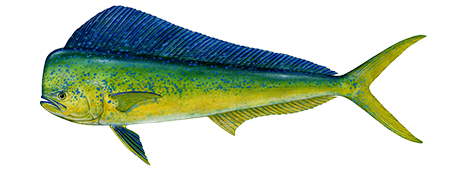
Dolphinfish
This fish is referred to as the dolphin fish to distinguish it from the dolphin of the porpoise family, which is a mammal and in no way related. They are extremely fast swimmers and feed extensively on flying fish and squid as well as on other small fish.

Region
South, Northeast
Catch ease
Medium
Habitat
Ocean
How to identify a Dolphinfish
The Dolphinfish is a distinctive fish, both for its shape and its colors. Though it is among the most colorful fish in the sea, the colors are quite variable and defy an accurate, simple description. Generally, when the fish is alive in the water, the dolphin is rich iridescent blue or blue-green dorsally; gold, bluish gold, or silvery gold on the lower flanks; and silvery white or yellow on the belly.
Large males have high, vertical foreheads, while the females’ forehead is rounded. Males grow larger than females. They have a particular affinity for swimming beneath buoys, seaweed, logs, and floating objects of almost any kind.
Where to catch Dolphinfish
The Dolphinfish can be found worldwide in tropical and warm temperate seas, the Dolphinfish is pelagic, schooling, and migratory. Though occasionally caught from an ocean pier, it is basically a deep-water species, inhabiting the surface of the open ocean. The following list includes places where you can catch Dolphinfish:
| Baitfish Patches |
| Deep Shore Water |
| Merging Water |
| Reefs, Wrecks, and Shoals |
| Coastal Waters |
| Floating Foam and Debris |
| Night Fishing |
How to catch Dolphinfish
It is believed that they can reach speeds up to 50 mph (80.5 kph) in short bursts. Successful fishing methods include trolling surface baits (flying fish, mullet, ballyhoo, squid, strip baits) or artificial lures; also live bait fishing or casting. If the first dolphin caught is kept in the water, it will usually hold the school, and often others will come near enough to be caught by casting.
The following are fishing methods you can use to catch Dolphinfish:
Dolphinfish lures, tackle & bait
The following are fishing lures, tackle or bait you can use to catch Dolphinfish:
